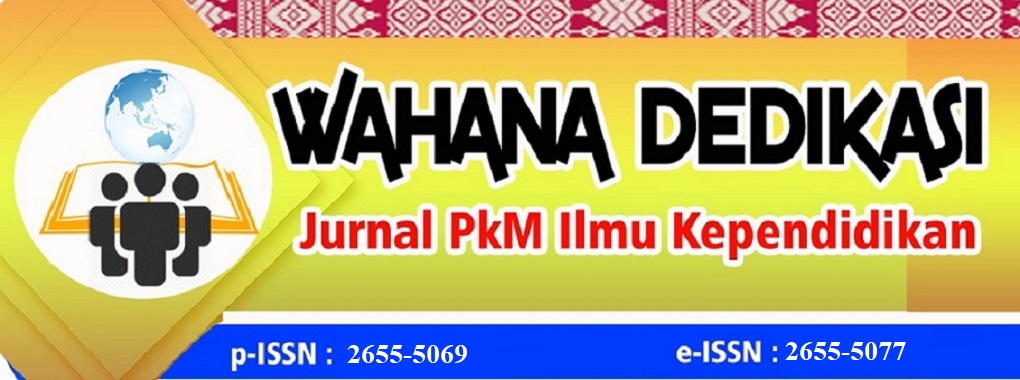IMPLEMENTASI SHUTTLE TIME TERPADU DALAM PEMASSALAN DAN PENGEMBANGAN OLAHRAGA BULUTANGKIS
DOI:
https://doi.org/10.31851/dedikasi.v2i2.5409Keywords:
Popularize, Development, Badminton, Shuttle TimeAbstract
Badminton sport coaching which tends to be instant causes a gap between athletes' achievements in Sijunjung Regency and sports activities for potential athletes of elementary school age. A program is needed that can socialize badminton among elementary school students that is able to foster interest and motivation to play badminton and form a coaching forum into the badminton coaching club. The integrated Shuttle Time program is an effort to socialize and increase interest in playing badminton in elementary school students in general in Sijunjung Regency. The partner in this activity is Ikatan Sarjana Olahraga (ISORI) the Sijunjung Regency. The key to implementing badminton with Shuttle Time is to provide badminton lessons that are cheaper, more interesting, fun and safe for elementary school students. The method used in this activity is through several stages, namely the first stage of direct field observation and coordination with related parties in this activity. The second stage provides Shuttle Time training for elementary school sports teachers and the third stage the teacher implements the shuttle time for students. The result of this activity is that the training activities will be carried out for 3 days and the teacher will get provisions in implementing this shuttle time in learning badminton in class hours and extracurricular development activities.Popularize and Development, Badminton Shuttle TimeReferences
Barnett, F., & Thomas, Y. (2012). The impact of exercise on the mental health and quality of life of people with severe mental illness : a critical review, (March 2014), 47–60. https://doi.org/10.4276/030802212X13286281650956
Drachsler, H. (2011). Learner Characteristics, (January). https://doi.org/10.1007/978-1-4419-1428-6
Glasow, P. (2005). Fundamentals of Survey Research Methodology
Harackiewicz, J. M., & Hulleman, C. S. (2010). The Importance of Interest : The Role of Achievement Goals and Task Values in Promoting the Development of Interest, 1, 42–52
Harper, S. (2012). The Leader Coach: A Model of Multi-Style Leadership. Journal of Practical Consulting, 4(1), 22–31
Kirca, A. H., Jayachandran, S., & Bearden, W. (2005). Market Orientation : A Meta-Analytic Review and Assessment of Its, (April). https://doi.org/10.1509/jmkg.69.2.24.60761
Omar, D., & Aman, M. S. (2009). Sports Facilities Development and Urban Generation, (April). https://doi.org/10.3844/jssp.2009.460.465
Osborne, R. E. (2013). Journal of Online Learning and Teaching It Can Be Taught : Explorations into Teaching the Foundations for Multicultural Effectiveness in an Online Course, (December)
Papa, S. (2017). The Effects of Physical Activity on Social Interactions : The Case of Trust and Trustworthiness The Effects of Physical Activity on Social Interactions : The Case of Trust and Trustworthiness, (July). https://doi.org/10.1177/1527002517717299
Science, I., Queen, H., & Queen, H. (2013). Guideline adaptation and implementation planning : A prospective observational study, (December 2016). https://doi.org/10.1186/1748-5908-8-49
Takaloo, N. M., & Ahmadi, M. R. (2017). The Effect of Learners ’ Motivation on Their Reading Comprehension Skill : A Literature Review, 10–21.
Woodward, M. (2011). SHUTTLE TIME. BWF Journal.
Downloads
Published
Issue
Section
License
Authors who publish this journal agree to the following conditions:The author has the copyright and entitles the journal to the first publication with works that are licensed simultaneously under the Creative Commons Attribution CC BY License which allows others to share their work with the recognition of the authorship of the work and initial publications in this journal.
Â
The author can make separate additional contract agreements for the non-exclusive distribution of published journal versions of the work (for example, posting them to the institutional repository or publishing them in a book), with recognition of the initial publication in this journal.
Â
Authors are permitted and encouraged to post their work online (e.g., in institutional repositories or on their websites) before and during the delivery process because it can lead to productive exchanges, as well as quotes that are earlier and larger than published works





.png)



